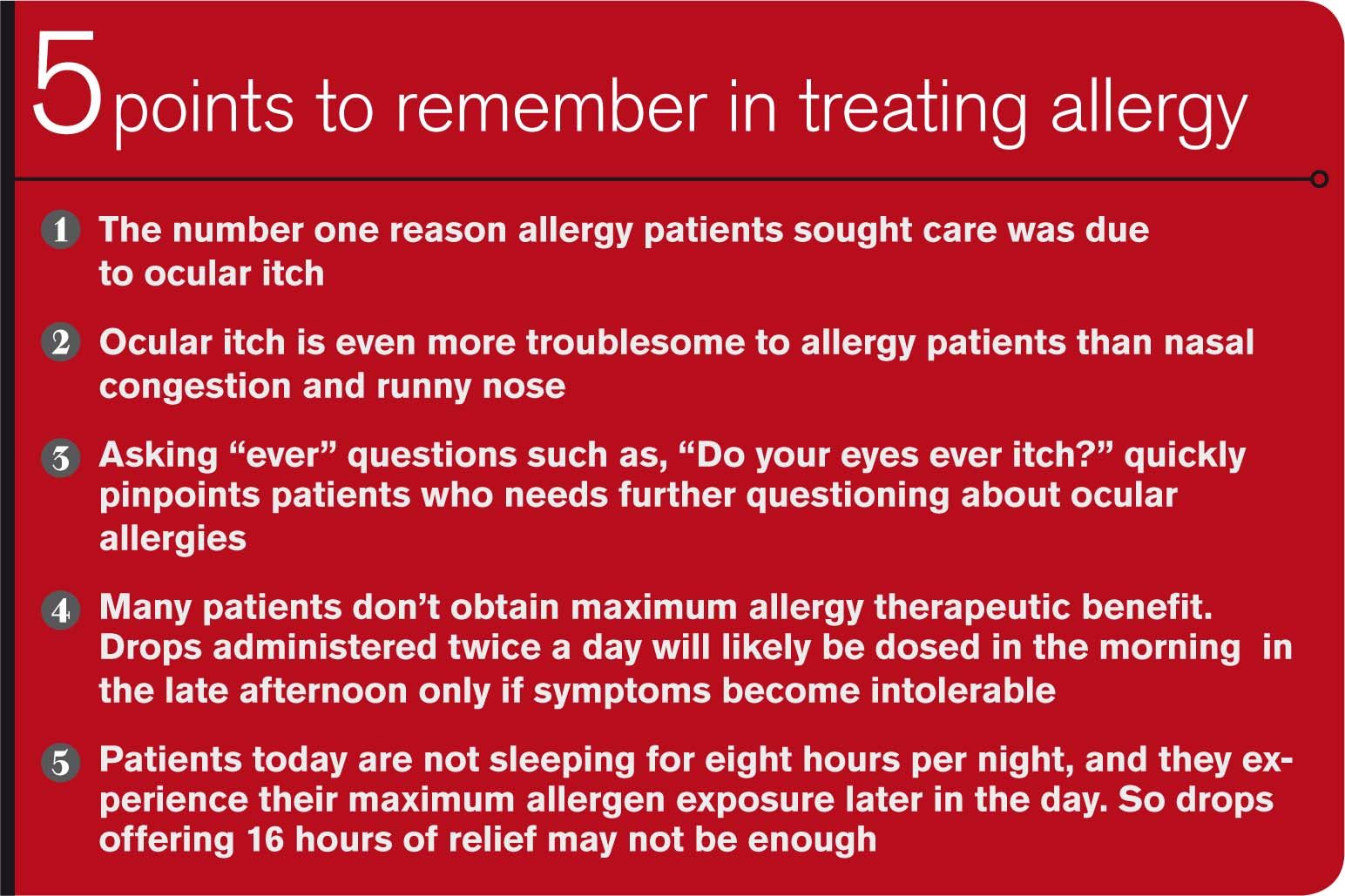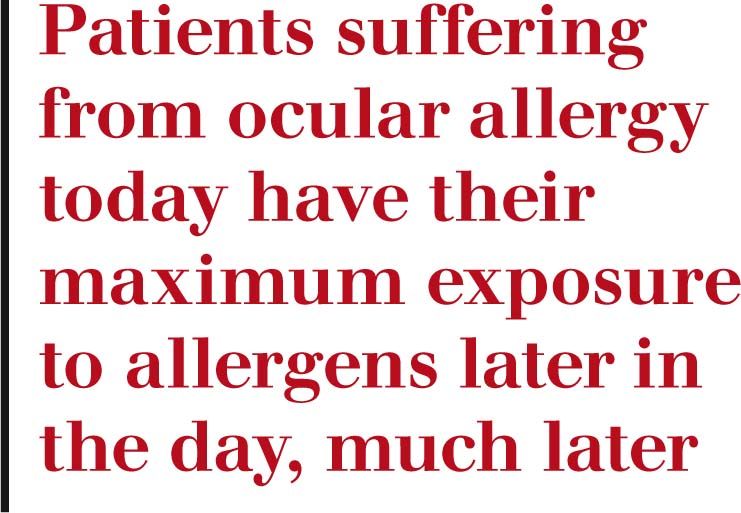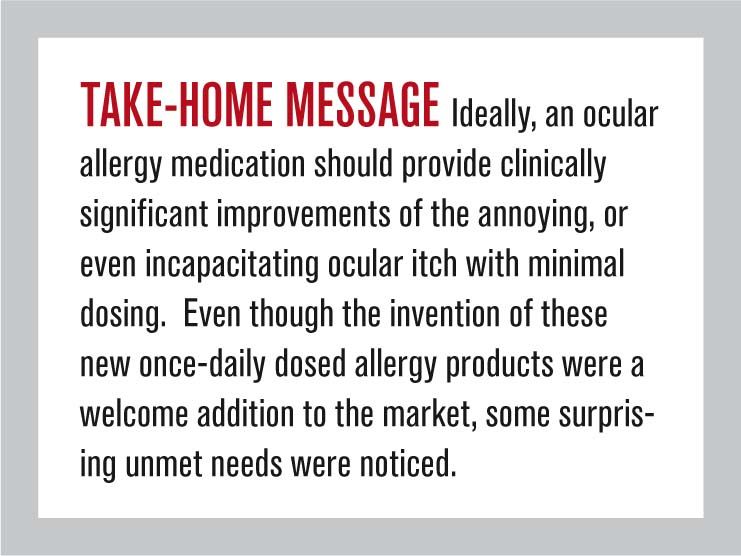Rethinking once-daily dosing on allergy medications
Ideally, an ocular allergy medication should provide clinically significant improvements of the annoying or even incapacitating ocular itch with minimal dosing. While this is a desirable goal, it leads to challenges of the amount of dosing to achieve this objective and patient compliance with such dosing.

Ideally, an ocular allergy medication should provide clinically significant improvements of the annoying or even incapacitating ocular itch with minimal dosing. While this is a desirable goal, it leads to challenges of the amount of dosing to achieve this objective and patient compliance with such dosing.
How critical is it to effectively treat the ocular itch in our allergy patients? Several recent studies have shown this goal is very important.
Some 500 healthcare providers from seven different specialties were interviewed about their allergy patients and what symptoms led these patients to seek medical care. These providers revealed the number one reason these patients sought their care was because of ocular itch. This symptom of ocular itch was even more troublesome to these patients than nasal congestion and runny nose.1 This means that the treatment of ocular itch as effectively as possible must become our primary goal.
Related: How to improve diagnosis and treatment of allergy
Diagnosing ocular itch
But to treat the ocular itch of allergies, we must first successfully make the diagnosis. And to make this diagnosis we must interview our patients during their eye examination, or they will be diagnosed and treated by other healthcare providers. A key reason this happens is because our patients rarely present for their routine eye examinations with signs or symptoms of ocular allergies.

But by asking a few “ever” questions such as, “Do your eyes ever itch?” or “Do you ever have allergies and take allergy medications?” we can quickly learn if this patient needs further questioning involving ocular allergies. This additional discussion will then lead to a better understanding if this patient ever has ocular allergies. We can then proactively prescribe for this patient-preventing him from self-treating or seeking another healthcare provider when allergy symptoms arise.
We have learned from glaucoma treatment that more dosing leads to lower compliance.2 Of course, glaucoma medication does not treat annoying symptoms such as itch, but nevertheless, a lesson can be learned from this information. Patients have the best of intentions and want to comply with treatment, but “life gets in the way.” This implies an allergy drop that is to be administered twice a day will likely be dosed once in the morning, and due to today’s hectic lifestyle, be dosed again in the late afternoon only if symptoms become intolerable. Obviously this creates a less-than-ideal situation in which the patient does not obtain maximum therapeutic benefit.
Next: Why once-daily dosing
Why once-daily dosing
This scenario created by the demanding lifestyle of today’s patient led to the creation of several allergy eyedrops approved for once-daily dosing, such as Pataday (olopatadine, Alcon) and Lastacaft (alcaftadine, Allergan). Initially it was believed that maximal therapeutic coverage for 16 hours would be sufficient. This concept allows for eight hours of sleep, a time with likely minimal allergy concerns. So it was postulated that once-daily dosing would be sufficient if 16 hours of therapeutic benefit was obtained. Even though the invention of new once-daily dosed allergy products were a welcome addition to the market some surprising unmet needs were noticed.
However, patients today are not sleeping for eight hours per night. The Center for Disease Control reports that over one third of Americans today are sleeping fewer than seven hours.3 This means that 16 hours of maximally therapeutic benefit for an allergy drop may not be enough.
More allergy: A new player in point-of-care allergy testing

Another interesting fact with these new once-daily drops designed for 16 hours of efficacy was many clinicians recommended dosing in the morning. Intuitively, this makes sense, but reality can be an entirely different matter. The reality is air conditioned air is a filtered environment that significantly reduces allergen count. So our patients get up in their air-conditioned homes and dose their allergy eyedrops. Then they drive to work in their air-conditioned cars to their air-conditioned offices. At the end of the work day, they return home, again in their air-conditioned cars. Once they get home, they notice the grass needs cutting, and this job should be finished in time to go to their sons’ baseball games. And because it is a nice evening, they’ll stop on the way home from the game for a quick bite at the diner that has outside tables. As we can see in this typical case, it is the end of the day when patients are exposed to the most allergens.
What about all the allergens that have collected in their hair during these outdoors activities? Because it’s now late and time for bed, patients grab a quick shower rinse without a shampoo. Patients go to bed and grind all the allergens collected in their hair into their pillows, which in turns gathers around the ocular adnexa during sleep. This can create significant ocular itching in the morning.

Patients suffering from ocular allergy today have their maximum exposure to allergens later in the day, much later. This exposure may be from allergens the patient is exposed to overnight dislodged from their hair or it could even be from dust mites in the mattress. But these allergens are definitely not being treated with the current 16-hour once-daily medications.
Next: New once-daily dosing therapy
New once-daily dosing therapy
The good news is clinicians can now effectively treat the ocular itch from allergies for 24 hours with Pazeo (olopatadine 0.7%, Alcon), the only U.S. Food and Drug Administration (FDA)-approved once-daily drop. To satisfy my curiosity regarding this claim, I prescribed Pazeo to a number of my patients who historically had used Pataday (olopatadine 0.2%, Alcon) to control the itch of ocular allergies. These patients said that Pazeo did not show any real difference in treating ocular itch at onset compared to Pataday. But when asked if they ever felt the need for more than once-daily dosing, nearly all of these patients disclosed they rarely had to dose Pazeo more than once during the day; many claimed they occasionally dosed Pataday more than once a day.

Pazeo contains a concentration of 0.7% olopatadine compared to 0.2% olopatadine for Pataday. The safety and effectiveness of Pazeo has been established in patients aged 2 and older with adverse reactions occurring in two to five percent of patients. Most common are blurred vision, dry eye, superficial punctate keratitis, dysgeusia, and abnormal sensation in the eye). It is worth noting these adverse reactions were similar and at the same rate as the vehicle.
For today’s patients suffering from the ocular itch of allergies 24/7, I have found Pazeo is a very welcome addition and should be considered when making our therapeutic recommendation.
References
1. Bielory L, Skoner DP, Blaiss MS, et al. Ocular and nasal allergy symptoms burden in America; the Allergies, Immunotherapy and Rhinoconjunctivitis (AIRS) surveys. Allergy Asthma Proc. 2014;35(3):211-218.
2. Stewart WC, Konstas AG, Pfeiffer N. Patient and ophthalmologist attitudes concerning compliance and dosing in glaucoma treatment. J Ocul Pharmocol Ther. 2004 Dec:20(6):461-9.
3. Center for Disease Control and Prevention. Morbidity and Mortality Weekly Report. 2011 March 4;60(8):1. Available at: http://www.cdc.gov/mmwr/PDF/wk/mm6008.pdf. Accessed 01/26/2015.
4. Pazeo [package insert]. Fort Worth, TX: Alcon Pharmaceuticals; 2015.
Newsletter
Want more insights like this? Subscribe to Optometry Times and get clinical pearls and practice tips delivered straight to your inbox.





.png&w=3840&q=75)


